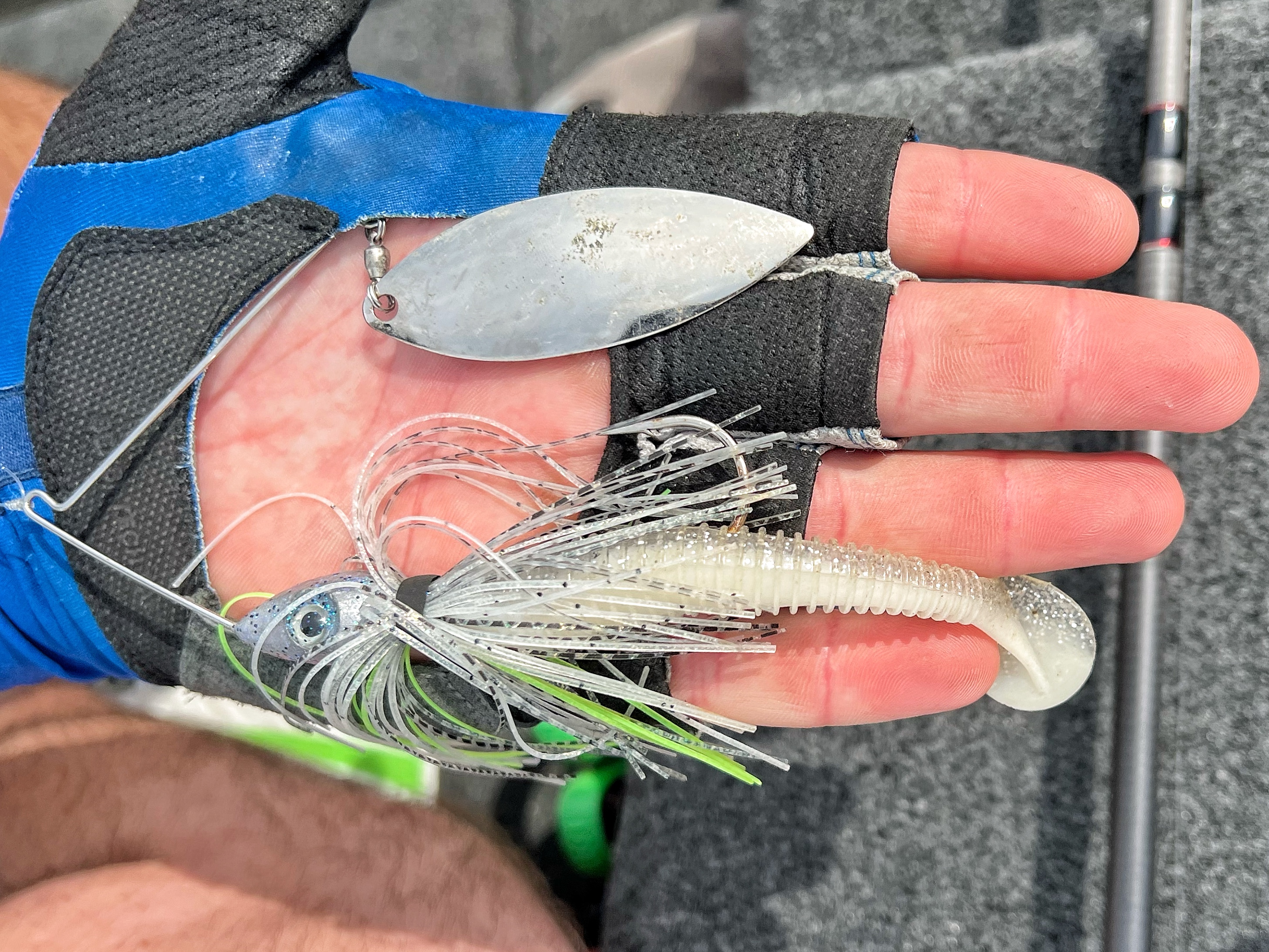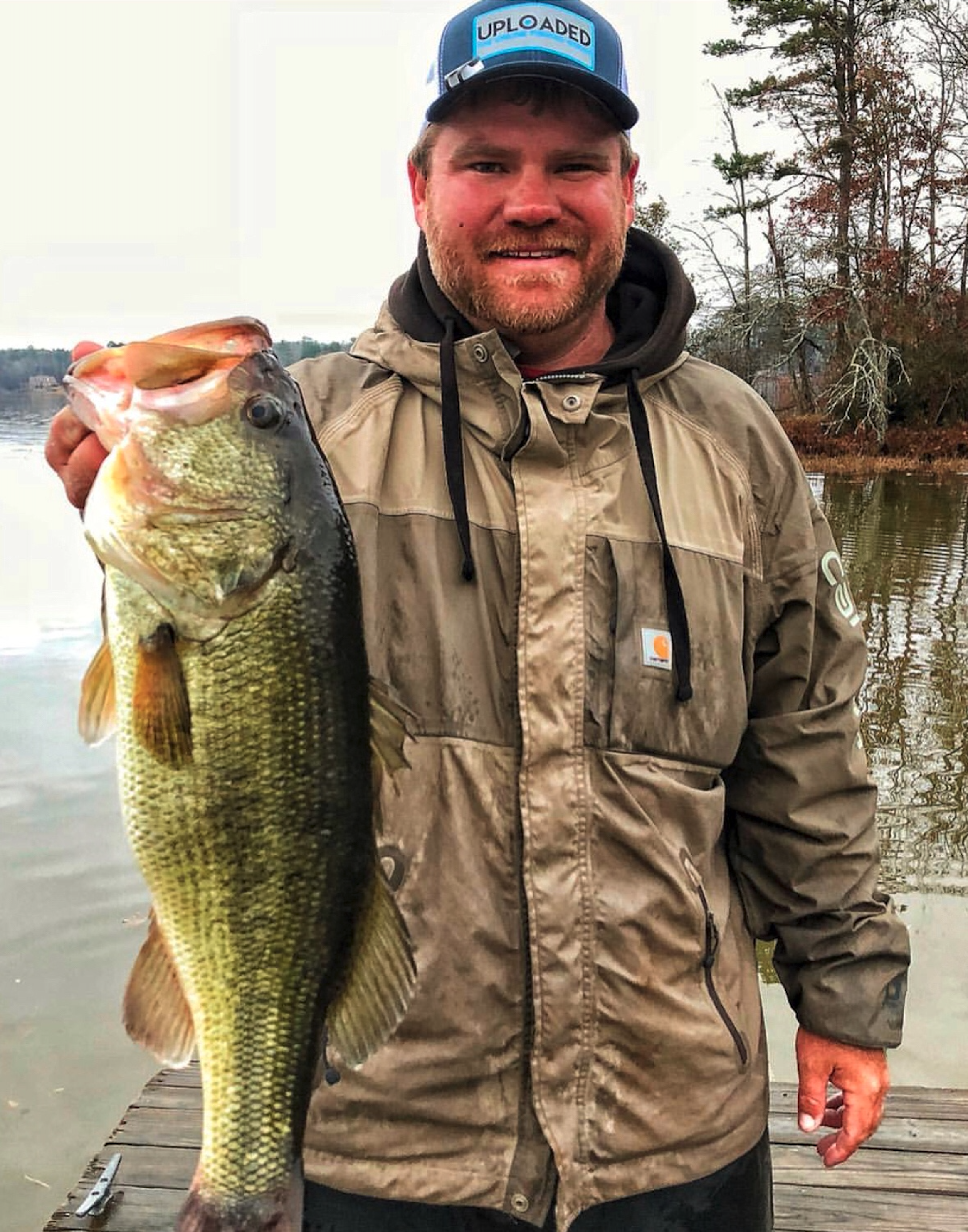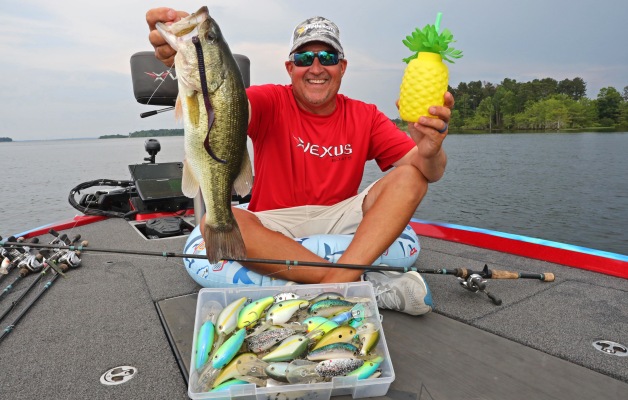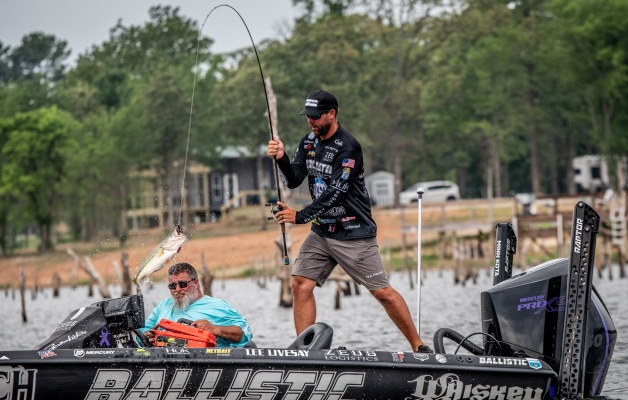
Bassmaster Elite Series Pro Drew Cook is one of the best sight fishermen on tour. If you want proof, you need look no further than the 105 pounds and 5 ounces of bass he amassed over four days to win his first blue trophy in 2022. Cook sight fished his way into the Bassmaster Century Club at the 2022 Guaranteed Rate Bassmaster Elite at Santee Cooper Lakes.
But you can’t be a one-trick pony on the Elites. That’ll get you put out to pasture real quick. An angler has to be versatile to compete here, on the big stage, chasing big bass and big dreams. So how does Cook catch big ones once they vacate the shallows and head offshore? A big spinnerbait.
“This one is a 3/4-ounce Nichols spinnerbait,” said Cook, holding one of his heavyweight spinnerbaits in the palm of his hand. “I get them to ship them to me with no blades, just the wire and head. Then I put the skirt on, and I change the blades around to whatever I want.”
Picking a blade
Cook varies his blade selection based on the depth of water he’s wanting to fish. For targeting bass around deeper brush, he’s found a smaller blade makes a big difference in the amount of time it takes the bait to reach the bottom, and the ease at which he can keep his bait there.
“A lot of times I’ll put a smaller willow blade on there when I’m fishing a ledge in 20 feet of water. I think this is a number 5. I can let it hit the bottom and can wind it pretty quick, and it’ll stay down there.”
Bigger blades create more resistance, which causes the bait to rise in the water column. Smaller blades create less resistance, which allows Cook to reel his spinnerbait faster while still keeping it down deeper.
“It’s something I’ll do postspawn. And it’s one of those rotational baits.”
Adding to the rotation
Cook explained that he uses a big spinnerbait out deep as a part of his arsenal, not as his sole offering to offshore fish. He’ll start with a fast moving crankbait. Then move to a swimbait.
“This is what I pick up right before I pick up a worm or a jig. This will be the last moving bait I throw through there. And this thing gets big bites. Not a lot of small fish are going to eat a big spinnerbait with a big blade and a big swimbait on it.”
Using a swimbait as a trailer, Cook can bulk up his presentation even more. The swimbait shown above is close to 4 inches long. He’ll go as big as 7 inches.
“It all depends on where you’re fishing and what you’re fishing for.”
Versatile spinnerbaits
In fisheries with bigger fish, Cook will go with a bigger swimbait. And on lakes where a 4-pounder is substantially larger that the rest of the bass around, he’ll dial his trailer back accordingly.
And though these big spinnerbaits do work best in stained water, color isn’t as necessary as you might think. Bass will bite a spinnerbait out deep in any color water, and Cook attributes this to the drawing power of the bait.
“Whether you make the right cast or not, fish can be 20 feet away and will swim over to eat this thing, because it knows it’s there. Where a regular swimbait, with just that little paddle tail, is not calling them in as much.”
The addition of a spinnerbait to Cook’s offshore arsenal does multiple things. For starters, these baits are fairly weedless and can be reeled right through the thickest cover. And they also present an effective alternative when offshore bass “get in a funk.”
“It’s good whenever they get really weird and suspend, especially after they’ve been just beat on with big crankbaits. They’ll just kind of rise up off the bottom, and they get super hard to catch when they do that.”
Having the ability to cast out a bait and easily count it down to 10 to 12 feet gives Cook a big bait option that will still trigger something instinctually in a giant bass, even when they’re not in an aggressive mood. And as far as forward-facing sonar goes, there are few bait that will show up better.
Working with sonar
“You’re sonar is going to reflect off of this really, really good. The biggest thing that I had to learn with forward-facing sonar is, 50 feet ain’t that far.”
An angler’s eyes can get a little big at times, and that’s not just when guessing the weight of a lunker. Cook has found that it’s extremely easy to overshoot fish that he sees on his sonar, especially early on.
“When you pull up to places and make a bomb cast, you’re probably throwing 200 to 250 feet. And a lot of times, whenever you get to using the sonar, you’ll overshoot a lot until you get dialed in. So this will help with that, and this is a great bait to catch them on with forward-facing sonar too.”
Cook says this approach works really well in standing timber also, offering a power fishing alternative to the finesse gear needed for drop shotting this kind of cover.
“This is 20-pound line. You can drop the hammer and bring them in. But one key with spinnerbait fishing, every day of a tournament, just put a new spinnerbait on.”
Bend but don’t break
S
Cook stressed this point, saying that it’s just a part of fishing spinnerbaits, especially those with big blades targeting big fish. The exaggerated vibration and the bending of the arm back and forth after each fish catch eventually leads to breakage in almost all baits like this.
“If you’re catching them on a spinnerbait, cut that one off and put a new one on. Cause sooner or later, after you’ve bent it back and forth a couple of times, it’s going to break. And you don’t want it to be in a tournament.”
If you take these spinnerbait tips from Drew Cook and apply them to your local fishery, you can hopefully unlock a new bite and become even more efficient with your forward-facing sonar.




